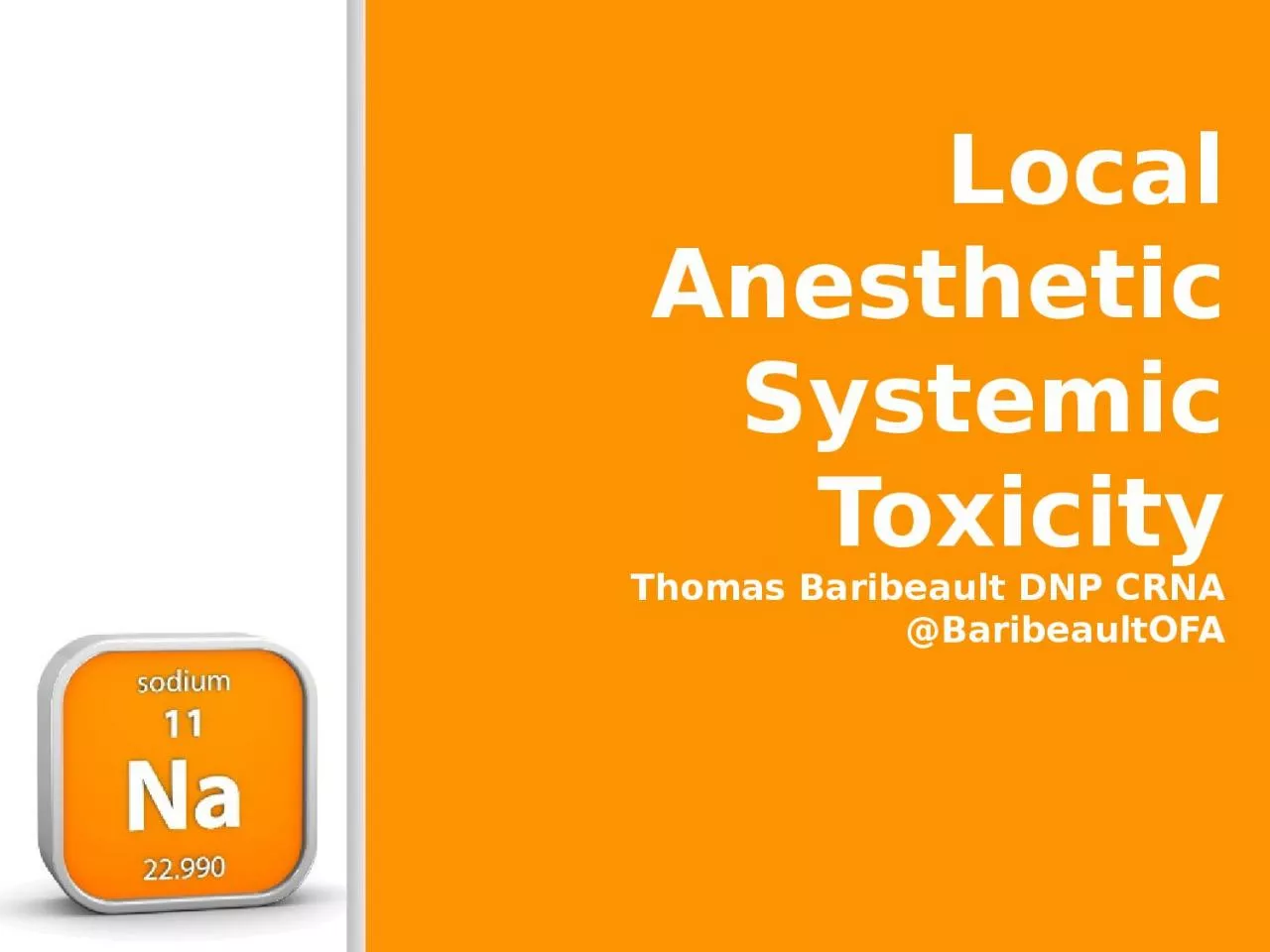

Thomas Baribeault DNP CRNA BaribeaultOFA Introduction Anesthesia is the art of the giving just the right amount of poison so that the patient survives being close enough to dead that they didnt notice getting cut open ID: 1006514
Download Presentation The PPT/PDF document "Local Anesthetic Systemic Toxicity" is the property of its rightful owner. Permission is granted to download and print the materials on this web site for personal, non-commercial use only, and to display it on your personal computer provided you do not modify the materials and that you retain all copyright notices contained in the materials. By downloading content from our website, you accept the terms of this agreement.
1. Local Anesthetic Systemic ToxicityThomas Baribeault DNP CRNA@BaribeaultOFA
2. Introduction“Anesthesia is the art of the giving just the right amount of poison so that the patient survives being close enough to dead that they didn’t notice getting cut open.”
3. Local AnestheticsLocal anesthetics (LA) bind to intracellular portion of the Na channel preventing nerve depolarizationLack many of the side effects of typical anesthetic agentsRespiratory depressionPONVImmune suppressionCardiac and Neurologic depressants
4. ComplicationsLASTCardiac and neurologicAllergic or anaphylaxisEstersMethemoglobinemiaPrilocaine, BenzocaineNeural, muscle, or tissue toxicity
5. LAST CausesExcessive doseAccidental vascular injectionRapid AbsorptionFactors that affect free plasma concentrationDecreased protein levelAcidosisLiver or kidney failureAbility of body to deal with LAHeart failure
6. LAST CausesRapid AbsorptionIVTrachealIntercostalCaudalParavertebralEpiduralBrachial plexusSpinalSciatic/Femoral
7. LAST CausesLA toxicityLidocaineMepivacaineRopivacaineBupivacaine
8. LAST CausesLA max doseLidocaine 5 mg/kg1.6 mg/kg/hrMepivacaine 5 mg/kgRopivacaine 3 mg/kg0.4 mg/kg/hrBupivacaine 3 mg/kg0.4 mg/kg/hr
9. LAST Signs40% of reported cases present atypicallyNeurologicGenerally appear before cardiacException bupivacainePre-medication can mask signsLA blocks inhibitory pathways in cerebral cortex leading to unopposed excitatory changes
10. LAST SignsNeurologicEarlyLightheaded/dizzyTinnitusMetallic taste/circumoral numbnessMiddleShivering/tremorsMyoclonus/tonic clonic convulsionsDisorientationLateSeizures
11. LAST SignsCardiacLow plasma concentration of LA Increased CO, BP, HRHigh plasma concentrations of LAVasodilationDecreased contractilityDysrhythmia prolonged PR, heart block, sinus arrestWidened QRS leading to v-fib
12. LAST & AcidosisHypercarbia/acidosis increases LAST effectsIncreased cerebral blood flowIncreased LA to brainDecreased protein bindingIncreased free plasma concentrationIntracellular acidosisIon trapping causes LA to stay intracellular in tissue
13. LAST PreventionLeast toxic drug, lowest dose, least risky blockSlow incremental injection/aspirate 3-5 mlMonitor ekg, pulse ox, bp minimum 30 minutes post blockDecrease dose for elderly and those with cardiac, hepatic, or renal dysfunction
14. LAST PreventionTest dose???Fentanyl 100 mcgDrowsinessEpinephrine 10-15 mcgHr increase 10 bpm or bp increase 15 mmhgUnreliable in elderly, sedated, on BBUSGRAVisualize your needle tip!!!
15. LAST TreatmentRECOGNITIONGet HelpControl Airway/hyperventilateSeizuresBenzodiazepineUse propofol with caution
16. LAST TreatmentACLS - modifiedEpinephrine 1 mcg/kgNo VasopressinAmiodaroneNot lidocaineAvoidBeta blockersCalcium channel blockers
17. LAST Treatment20% lipid emulsion1.5 ml/kg bolusCan be repeated 1-2x 0.25 ml/kg/min for 30-60 minutesCan be doubled if ROSC but bp low
18. LAST Treatment20% lipid emulsionLipid sinkLarge intravascular lipid volume binds and inactivates LALipid FluxLocal anesthetics inhibit cardiac metabolism of lipids
19. LAST Treatment